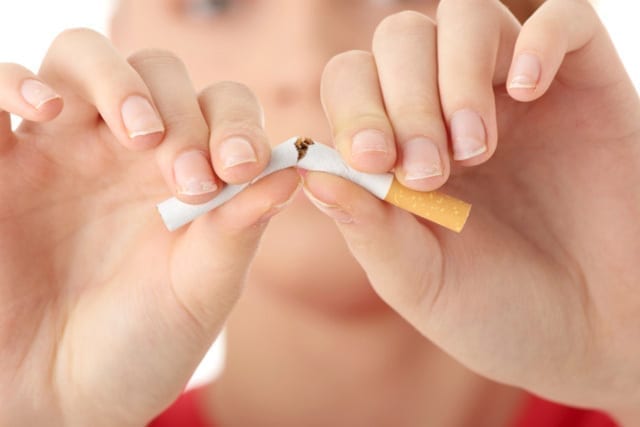The Breathe-Free Program was developed with Daniel Seidman from New York-Presbyterian/Columbia as well as the Cleveland Clinic team. Before you leave this story because you’re a nonsmoker, understand this breathe-free program isn’t only an anti-smoking plan. It serves as a prototype for the way you can address any kind of addictive behavior or substance.
So read on, subbing in your own addictions to get the idea for how you can address them. One of the most powerful addictions isn’t bridal reality shows; it’s cigarette smoking.
Step 1: Assess Yourself
Answer the following questions to see if you’ve lost control of your smoking behavior and it’s turned into a dependence.
- Have you smoked every day for the past several weeks?
- Do you experience any of the following withdrawal symptoms after you stop or reduce your amount of smoking (withdrawal symptoms can begin within a few hours of cessation)?
- Depressed mood
- Insomnia
- Irritability, frustration or anger
- Anxiety
- Difficulty concentrating
- Restlessness
- Decreased heart rate
- Increased appetite or weight gain
- Do you experience significant distress due to the symptoms in question 2? Do you avoid social or work obligations, or leave in the middle of these obligations, due to distress or discomfort from not smoking?
If you answered yes to question 1, yes to at least four symptoms in questions 2, and/or yes to question 3, then you may meet the definition for nicotine addiction. Knowing this can help build your commitment to learning how to breathe free.
QUIZ: Are You Feeling Stressed?
- In the past year, was there a day you didn’t smoke at all—not even a puff? If you said yes, think about how you did it and how you then went back to smoking. Try to learn from this experience.
If you answered no, don’t despair. The movie in your head about how impossible it is to break free of smoking is exaggerated. With proper use of medicines and a good behavioral plan, it’s possible to break free of smoking. We’ve helped more than 700 people individually and more than 80,000 using our web-based programs (oprah.com or realage.com). If you follow our plan and have a buddy to help, we believe your chance of success is over 60 percent each time you try—so three tries will get you to over a 90 percent chance of success.
- Do you continue to smoke despite having a tobacco-related medical problem such as bronchitis or COPD (chronic obstructive pulmonary disease)?
Smokers are well aware of the medical problems associated with smoking. After all, they are listed on every pack you smoke. Even when told it is a matter of life and death, many continue smoking, even after lung surgery, oral cancer or heart attack. This behavior mystifies your loved ones, and even leaves you bewildered, yet it’s a hallmark of addiction and distinguishes it from “bad habits,” which also involve automatic behavior. The difference is that bad habits don’t predictable put your life in jeopardy—a 20-can-a-day diet soda habit doesn’t invariably result in troubles.
- Do you get less of an effect than you once did—of pleasure or satisfaction—from the same number of cigarettes each day?
- Do you continue to smoke, even though you enjoy 10 to 20 percent of the cigarettes you light up?
If you answered yes to questions 6 and 7, know that many get sick of their addiction in time, especially after age 40. What was fun and social becomes rote habit with less pleasure than advertised. Keeping this in mind may motivate you to move forward with breathing free.
- Do you still enjoy smoking most or all of the time?
If you answered yes, ask yourself—would it be nice to shed the burden of shame and guilt you carry from smoking?
- Do you feel anxious and nervous, and has this continued every day for the past two weeks?
If you answered yes, you may have more anxiety about getting through your breathe-free day (the first day without cigarettes). In that case, you may need to pay extra attention to the next step—working on preparation, confidence building and motivation.
- Do you feel sad and blue, and has this continued every day for the past two weeks.
If you said yes, you may have more emotional discomfort after getting through your breathe-free day. Your nicotine withdrawal symptoms might be harder so work out your strategies with an expert.




































